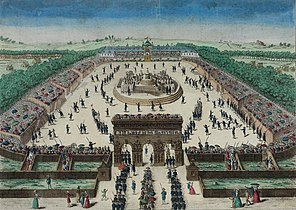Champ de Mars
The Champ de Mars (French pronunciation:
The nearest
History
Originally, the Champ de Mars was part of a large flat open area called Grenelle, which was reserved for market gardening. Citizens would claim small plots and exploit them by growing fruits, vegetables, and flowers for the local market. However, the plain of Grenelle was not an especially fertile place for farming.
The construction, in 1765, of the
The
Jacques Charles and the Robert brothers launched the world's first hydrogen-filled balloon from the Champ-de-Mars on 27 August 1783.[1]
This place witnessed the spectacle and pageantry of some of the best-remembered festivals of the
The Champ de Mars was also the site of the
The Champ de Mars was the site of
In art, culture, film and sport

Art and culture
In 2012, the United Buddy Bears exhibit was held on the Champ de Mars, an international art exhibition with more than 140 two-meter-tall bears representing individual countries. They promote peace, love, tolerance and international understanding and are displayed across the planet. They stand at Champ de Mars in Paris, fronting the Eiffel Tower.[6]
Use in film and television
Champ de Mars was used as a filming location in the 1985
Sports
Champ de Mars contains both a basketball court and a football field, and it will be the site of beach volleyball at the 2024 Summer Olympics and of five-a-side football at the 2024 Summer Paralympics.
As of March 2023, the basket at the northern end of the basketball court was damaged and hanging downward.
Gallery
-
Illustration of the Fête de la Fédération at Champ de Mars, July 14, 1790 (Musée de la Révolution française).
-
Illustration of massacre on the Champ-de-Mars, 1791.
-
Painting of The Festival of the Supreme Being, June 8, 1794 (by Pierre-Antoine Demachy, 1794).
-
Illustration of Fête de la Concorde, May 21, 1848.
-
Photograph of Exposition Universelle, 1867.
-
Panoramic view of Exposition Universelle, 1878.
-
View of Exposition Universelle, 1889.
-
Illustration of Exposition Universelle, 1900.
-
Champ de Mars at night (2007).
-
Champ de Mars – view from theMontparnasse Tower(2010)
-
The north end of Champ de Mars and Quai Branly – As viewed from the Eiffel Tower (2016)
See also
- List of world's fairs
- Champ de Mars Massacre
- Fête de la Concorde
- Monument to the French Declaration of the Rights of Man and of the Citizen
References
- ^ Medal commemorating Charles and Robert’s balloon ascent, Paris, 1783 from Science and Society, 2010.
- ^ Encyclopedia of the age of political revolutions and new ideologies: 1760–1815, Gregory Fremont-Barnes; Greenwood Press, CT, 2007; p. 237
- ^ A Cultural History of the French Revolution, Emmet Kennedy; Yale Univ. Press, 1989; p. 345.
- ^ Kennedy, 1989; p. 345.
- ^ Thiers, Adolphe (1865). History of the Consulate and the Empire of France Under Napoleon. Lippincott. p. 553.
- ^ "Worldatlas: United Buddy Bears in Paris in 2012". Worldatlas.com. Archived from the original on 31 March 2017. Retrieved 18 October 2014.
- ^ "A View to a Kill (1985)". IMDb. Retrieved 18 October 2014.











